Your root cellar needs a consistent temperature between 32-40°F (0-4°C) to keep your produce fresh and prevent spoilage. You'll want to maintain humidity levels between 85-95% to stop vegetables from withering or developing mold. Different vegetables require specific temperature zones – root vegetables like carrots and beets need the coldest spots at 32-40°F with high humidity, while garlic and onions prefer cooler, drier areas around 35-40°F. To achieve these conditions, you'll need proper insulation, ventilation, and regular monitoring. Understanding how to manage these temperature zones can transform your storage success.
The Ideal Root Cellar Temperature
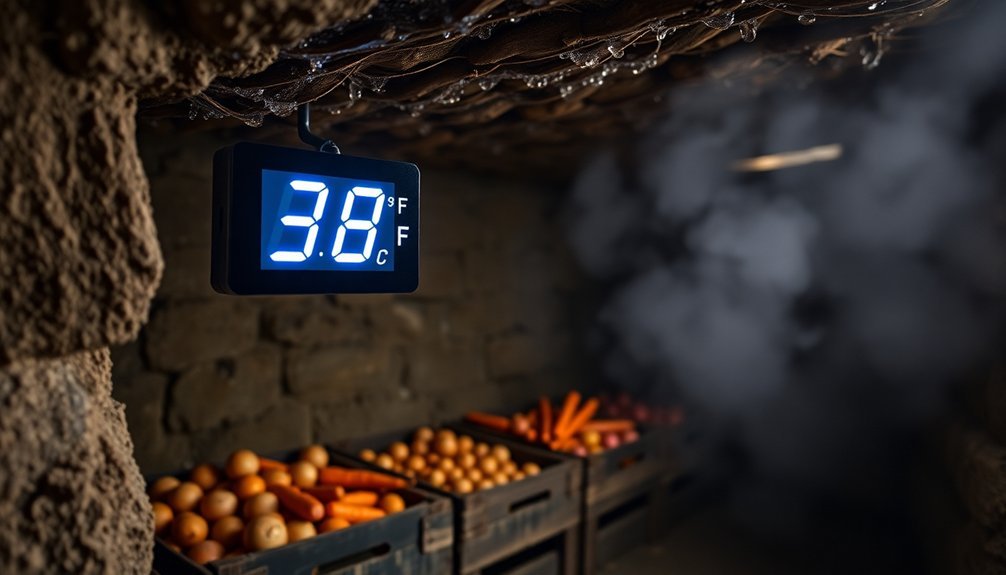
You'll find that achieving this ideal temperature range often requires careful planning and design considerations.
The steady temperature control helps prevent vegetables from spoiling prematurely.
If you're building a root cellar, consider digging deeper into the ground where temperatures remain more stable, typically around 52°F. You can then use various methods to lower this temperature to the desired range.
Adding proper insulation, such as sand, helps maintain consistent temperatures, while installing ventilation systems with closable exhaust pipes allows you to take advantage of cool night air for temperature regulation.
In warmer climates, you might need to implement additional cooling strategies like evaporative cooling systems.
Remember that your local climate and groundwater conditions will influence how easily you can maintain these best temperatures, so you'll need to monitor and adjust accordingly.
Temperature Zones For Different Vegetables
Root cellars require distinct temperature zones to properly store different types of produce.
You'll need to organize your storage space based on four main temperature and humidity zones to maximize the shelf life of your vegetables and fruits.
In the coldest and very damp zone (32-40°F with 90-95% humidity), you'll want to store root vegetables like beets, carrots, parsnips, and turnips. This zone's high moisture helps prevent these vegetables from drying out. Using dirt floors in this zone helps maintain optimal humidity levels naturally.
The cold and damp zone (32-40°F with 80-90% humidity) is perfect for storing apples, cabbage, potatoes, and citrus fruits.
For produce that needs slightly warmer temperatures, use the cool and damp zone (40-50°F with 85-90% humidity). This area works well for short-term storage of vegetables like cucumbers, eggplants, and ripe tomatoes.
Finally, you'll need separate cool and dry (35-40°F with 60-70% humidity) and moderately warm and dry (50-60°F with 60-70% humidity) zones.
Store garlic and onions in the cool, dry area, while pumpkins, sweet potatoes, and winter squash belong in the warmer, dry space.
Humidity and Temperature Balance

With temperature zones established, maintaining the right balance between temperature and humidity becomes the next essential factor in root cellar success.
In-ground designs provide natural temperature regulation.
You'll need to keep the temperature between 32-40°F (0-4°C) while maintaining humidity levels of 85-95% for ideal storage conditions. This combination slows down vegetable decay while preventing moisture loss.
You can't focus on temperature alone, as proper humidity is equally important. If your humidity drops below 85%, your vegetables will wither and lose flavor, even if the temperature is perfect.
Conversely, if humidity rises too high while maintaining ideal temperatures, you'll risk mold growth and rot. That's why proper ventilation is vital – it helps manage both factors simultaneously.
To maintain this delicate balance, you'll need to monitor conditions regularly using thermometers and hygrometers.
When you notice humidity dropping, add moisture through methods like moist wood shavings. If temperatures start climbing above 40°F (4°C), adjust your ventilation to allow more cool air flow.
Managing Cold Air Flow
A well-designed ventilation system lies at the heart of cold air management in your root cellar. You'll need to strategically position your vents to take advantage of natural air movement – install inlet vents near the floor where cool air enters, and outlet vents near the ceiling where warm air exits.
| Ventilation Element | Best Practice |
|---|---|
| Inlet Vent Location | Near floor, 3-4" diameter |
| Outlet Vent Location | Near ceiling, extended outside |
| Vent Positioning | Opposite sides of cellar |
| Flow Direction | Bottom to top movement |
| Maintenance Needs | Regular debris clearing |
To maximize airflow efficiency, you'll want to install vertical ventilation through the ceiling or roof whenever possible, though horizontal ventilation on opposing walls works too. Make sure there's enough space between your storage bins and walls to allow proper air circulation. You'll need to monitor for condensation, which signals poor air movement – if you spot any, extend your outlet vent pipes further outside. During nighttime hours, open your vents to let in the coolest air. Remember to check your vents regularly for blockages and clear any debris that might restrict airflow.
Preventing Temperature Fluctuations
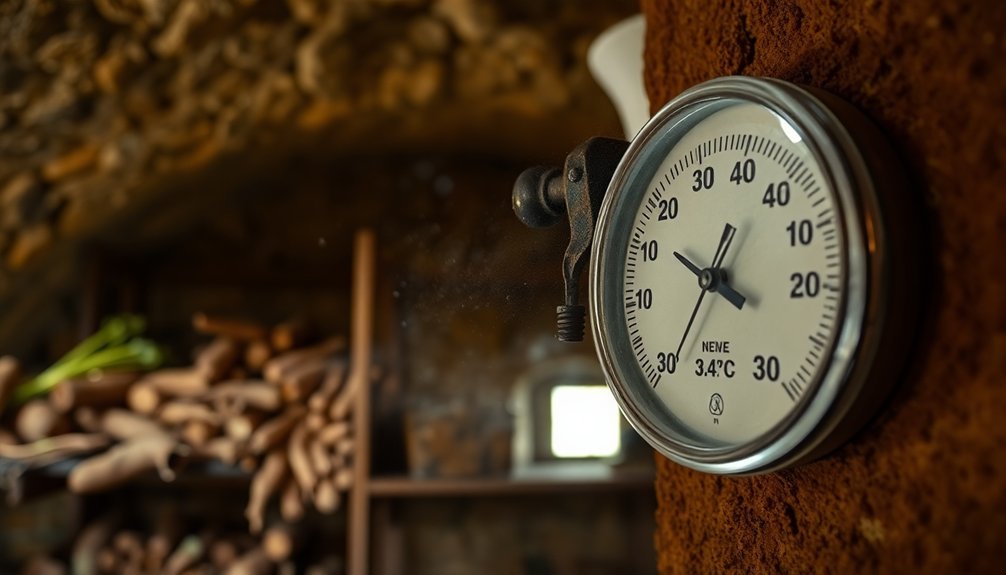
To protect your root cellar from unwanted temperature swings, you'll need to layer multiple insulation methods, such as rigid foam on exterior walls combined with mineral wool batts in the ceiling.
You can effectively maintain stable temperatures by using concrete walls with insulating blankets or straw bales, making sure they're properly ventilated to prevent moisture buildup.
Monitor your cellar's temperature daily and adjust your ventilation controls accordingly, as even small fluctuations can impact the longevity of your stored produce.
Insulation Methods That Work
Maintaining consistent temperatures in your root cellar depends heavily on proper insulation methods that prevent unwanted fluctuations. You'll find success using either natural or synthetic materials, each offering unique benefits for temperature control.
For a natural approach, you can use straw bales or earthbags to create effective insulation barriers. If you're building into a hillside, you'll benefit from the earth's natural insulation properties at depths of 10 feet or more.
Remember to include proper ventilation to prevent moisture buildup and mold growth.
Synthetic options include rigid foam insulation and foam plastic sheets, which work best when incorporated during initial construction. You'll need at least six sheets of 20mm-thick foam plastic around the structure for peak results.
Don't forget to seal all gaps thoroughly to maintain effectiveness.
Your roof requires special attention since heat rises. Layer it with wood, concrete, or metal, then add straw, hay, or foam insulation.
Consider installing a green roof with plants for additional natural insulation.
Combine your insulation strategy with a dual ventilation system, placing vents near both the floor and ceiling to create natural air circulation that maintains temperatures between 32° and 40°F.
Monitoring Daily Temperature Changes
Successful temperature control in your root cellar depends on up-to-the-minute monitoring of daily fluctuations.
You'll need to establish a reliable system that helps you maintain the ideal storage conditions between 32-40°F (0-4°C). By using multiple thermometers positioned at different levels, you can quickly identify any temperature variations that might affect your stored produce.
To effectively monitor and manage daily temperature changes, implement these essential practices:
- Check thermometer readings at least twice daily, focusing on floor-level and ceiling measurements to track warm air movement.
- Install a 100-watt light bulb near the floor as a controllable heat source during cold spells.
- Utilize concrete walls and floors as thermal mass to naturally stabilize temperature.
- Maintain proper ventilation systems to regulate air circulation and prevent hot spots.
- Adjust insulation and ventilation settings based on your daily temperature readings.
If you notice significant temperature swings, you'll need to take immediate action.
Your concrete walls will help buffer against sudden changes, but you should regularly inspect your insulation and ventilation systems to verify they're working effectively.
Remember that maintaining a steady 85-95% humidity level is equally important for peak storage conditions.
Root Vegetables Storage Requirements
Proper storage of root vegetables demands precise temperature and humidity control to maximize shelf life. You'll want to maintain temperatures between 32° and 38°F, as this range effectively slows down respiration and prevents deterioration.
Most root vegetables thrive in environments with 90-95% relative humidity, which helps prevent shriveling and maintains their crisp texture.
When storing your root vegetables, you'll need to keep them in covered bins with adequate ventilation to prevent mold growth and eliminate ethylene gas buildup. For carrots and parsnips, arrange them vertically in sand, ensuring they don't touch each other to prevent rot spread.
You'll also want to separate onions and potatoes, as they can transfer flavors and moisture between them.
Don't store your root vegetables with apples, as the ethylene gas they produce can affect vegetable quality. Use insulation and thermostats to maintain consistent temperatures, and regularly check moisture levels in your storage medium.
If you're using a refrigerator, be cautious of excessive humidity that can lead to rot. Remember to store potatoes and onions in low-light conditions to preserve their quality.
Seasonal Temperature Adjustments
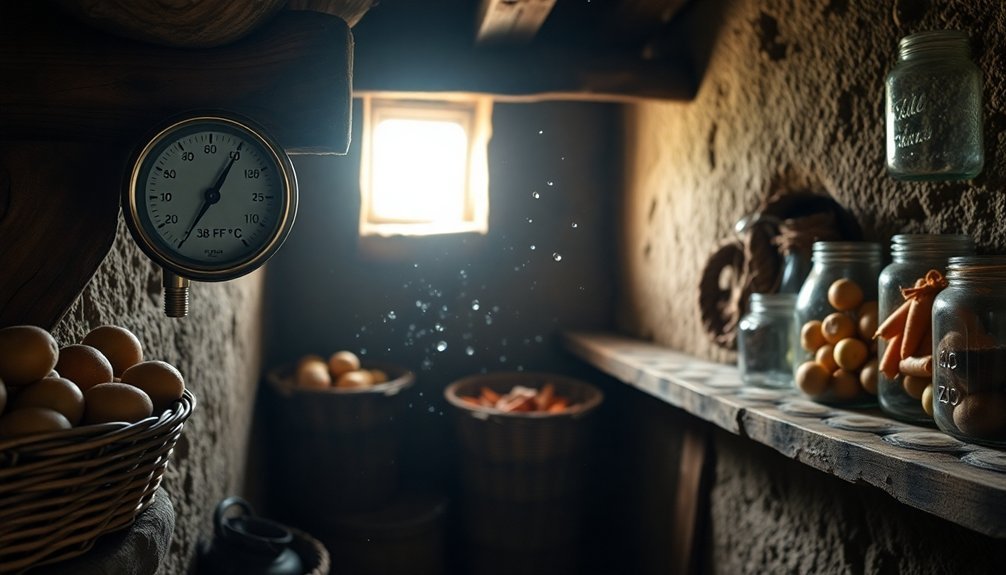
Your root cellar requires careful temperature adjustments as seasons shift, starting with Fall preparation using straw bale insulation and draft sealing to trap heat.
During Winter, you'll need to protect against freezing by using insulated containers with boiling water and monitoring cold spots with thermometers.
When Spring arrives, you can changeover by increasing ventilation at night, using ice blocks for supplemental cooling, and adjusting your storage items to those that tolerate warmer temperatures.
Fall Preparation Strategies
Fall preparation marks a critical time for root cellar temperature management, as outdoor temperatures begin their seasonal descent.
You'll need to focus on insulation, ventilation, and draft prevention to maintain ideal storage conditions between 32° and 40°F. Start by inspecting your cellar's insulation and adding straw bales along interior walls if needed. Check all seals around doors and windows, applying weatherstripping to prevent unwanted air infiltration.
Your fall preparation checklist should include these essential tasks:
- Install thermometers in different zones to monitor temperature variations
- Screen all ventilation openings to keep rodents out while allowing proper air flow
- Cover windows with opaque materials or wooden shutters to control light exposure
- Seal any gaps or cracks in walls and floors before cold weather arrives
- Test ventilation systems to verify they're working properly
Take advantage of cool fall nights by opening vents to let in cold air, but remember to close them during warmer daytime hours.
You'll want to establish this ventilation routine before winter sets in. If temperatures drop too low, have a 100-watt light bulb ready as an emergency heat source.
Winter Temperature Management
During winter, managing root cellar temperatures requires careful attention to both daily and seasonal fluctuations.
You'll need to maintain temperatures between 32-40°F (0-4°C) to keep your vegetables fresh and prevent both freezing and premature sprouting. Monitor your thermometer regularly, as temperatures below 32°F can damage your produce, while those above 40°F can trigger unwanted growth.
Winter is your opportunity to create ice reserves for summer cooling. When outdoor temperatures drop to at least 5°F (-15°C), fill Rubbermaid containers with water and let them freeze.
You'll want to store enough ice to fill approximately one-third of your cellar's volume. This ice will act as a natural cooling battery during warmer months. Don't forget to set up a drainage system for the inevitable melt water.
Take advantage of your cellar's natural insulation by ensuring it's properly situated below the frost line. If you've built your cellar into a north-facing hill, you're already ahead of the game.
Keep your ventilation system working efficiently to maintain humidity levels between 85-95%, and adjust your vents as needed to regulate both temperature and moisture levels.
Spring Transition Methods
As winter gives way to spring, maintaining ideal root cellar temperatures becomes more challenging.
You'll need to actively manage ventilation and light exposure to keep your storage space within the best 32-40°F range. Opening vents during cool nights and closing them in the morning helps trap cooler air inside, while blocking direct sunlight prevents unwanted heat buildup.
Temperature monitoring becomes essential during this changeover period. Place thermometers throughout your cellar to track temperature variations and adjust your cooling strategies accordingly.
When the storage room exceeds 40°F, you can supplement cooling by using ice blocks or cold water containers, being careful not to create excess moisture.
Key actions for spring temperature management:
- Open vents at night when outdoor temperatures drop
- Use wooden shutters or opaque covers on windows during daylight hours
- Screen all openings to prevent pest entry while maintaining airflow
- Monitor temperatures in different cellar zones regularly
- Add supplemental cooling methods when needed, but avoid overcooling
Remember to check ventilation pipes for proper screening and maintain consistent airflow to reduce ethylene gas buildup, which can accelerate produce spoilage.
Your diligence in managing these spring changes will help preserve your stored items longer.
Monitoring Tools and Equipment
Modern technology has revolutionized root cellar monitoring with an array of wireless and WiFi-enabled sensors. You'll find several reliable options to track your cellar's conditions, from battery-operated devices like Netatmo and La Crosse Alerts to WiFi-enabled solutions like ThermoWorks NODE and ConnectSense.
| Device | Power Source | Key Features |
|---|---|---|
| Netatmo | Batteries | Smartthings integration, smartphone app |
| La Crosse | AAA batteries | Multiple sensors, free mobile alerts |
| ThermoWorks | Year-long battery | Waterproof, cloud access |
When choosing your monitoring system, you'll need to evaluate power requirements. While battery-operated sensors like Netatmo and La Crosse offer flexibility in placement, plugged-in options like Particle Photon and ConnectSense provide more reliable continuous monitoring. Most systems allow you to check temperatures remotely through smartphone apps and send alerts when conditions fall outside your preset ranges. For thorough monitoring, you can integrate these sensors with smart home systems like Smartthings, allowing you to expand your setup with additional sensors and switches for complete cellar automation. Installation is typically straightforward, with options for wall mounting, magnetic attachment, or freestanding placement.
Natural Cooling Methods
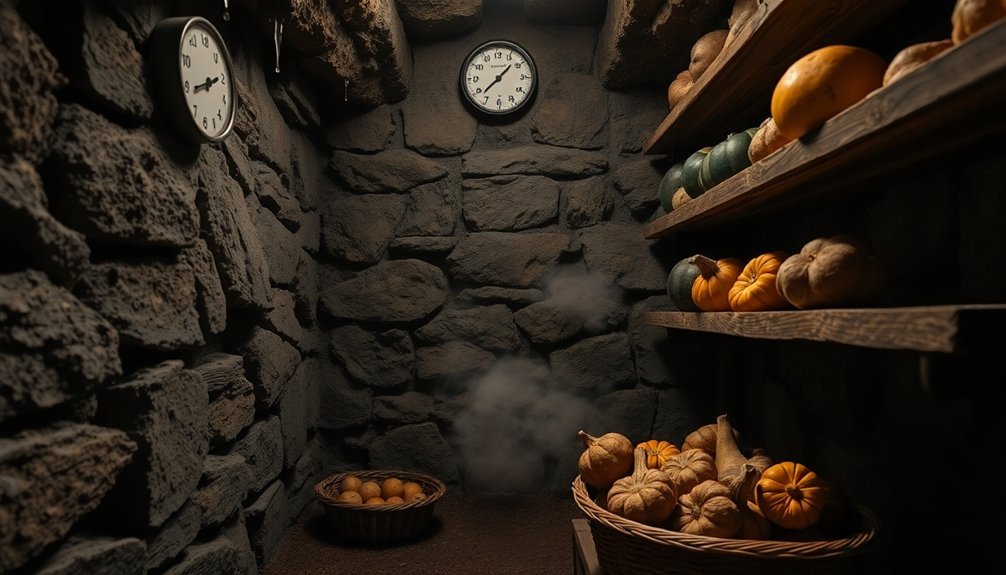
Taking advantage of the earth's natural insulation is one of your best strategies for maintaining ideal root cellar temperatures.
When you build your cellar into a hillside or below ground, you'll benefit from the earth's consistent temperature, which naturally stays between 50-55°F year-round.
You can enhance this cooling effect by installing properly positioned vents that create a natural chimney effect, pulling cool air in through lower vents while allowing warmer air to escape through upper vents.
Earth's Natural Insulation Properties
Nature provides us with one of the most effective temperature control systems through Earth's remarkable insulation properties. When you dig just a few feet into the ground, you'll find that the earth acts as a massive thermal capacitor, helping maintain stable temperatures year-round.
For root cellar construction, this natural insulation becomes invaluable, though you'll need additional insulation for ideal performance.
The earth's insulating properties work in your favor through several key mechanisms:
- A foot of moderately dry earth provides an R-value of approximately 5, creating a natural barrier against temperature fluctuations.
- At 4 feet deep, soil temperatures remain relatively stable throughout the year, varying primarily by your geographic location.
- The earth's thermal mass helps buffer against sudden temperature changes, protecting your stored goods.
- Underground water sources can influence soil temperatures, which you can leverage for additional cooling.
- The surrounding soil creates a natural temperature gradient that you can enhance with proper ventilation and design.
While earth alone won't maintain perfect root cellar temperatures, it provides an excellent foundation for your temperature control strategy when combined with other cooling methods.
Air Circulation Through Vents
While Earth's natural insulation provides the foundation for root cellar temperature control, proper air circulation through strategically placed vents maximizes cooling effectiveness.
You'll need to position your intake vents low to the ground and outlet vents near the ceiling, creating a natural flow as cool air enters and warm air escapes. Place these vents on opposite walls to guarantee ideal cross-ventilation.
You can enhance your ventilation system's effectiveness by sealing around the vents with packed cloth, expanding foam, or rubber gaskets. This control allows you to manage airflow precisely.
During summer nights, open your vents to let in cool air, but keep them tightly closed during winter to maintain stable temperatures.
Your ventilation strategy isn't just about temperature control – it's vital for maintaining proper humidity levels and removing ethylene gases that vegetables release.
You'll want to aim for 90-95% humidity while keeping the temperature between 32-40°F. This combination of proper ventilation and temperature control prevents mold growth, removes unwanted odors, and creates the ideal environment for long-term food storage.
Remember to monitor these conditions regularly, as different foods may require slight variations in storage conditions.
Temperature Control Through Insulation
A well-insulated root cellar serves as your primary defense against temperature fluctuations. You'll need to insulate all sides of your cellar, including walls, ceiling, and floor, to maintain temperatures between 32-40°F or 42-52°F.
Using materials like foam boards, straw bales, or foam plastic sheets (20mm thick) can effectively regulate the environment and help maintain humidity levels between 85-95%.
When installing insulation, you'll want to pay special attention to the ceiling, as heat from above can greatly impact your cellar's temperature.
Combine your insulation strategy with proper ventilation to create a superior storage environment that prevents ethylene gas buildup and maintains consistent conditions.
- Use foam boards or plastic sheets for walls and floor protection
- Install straw bales around the exterior for natural temperature control
- Apply composite deck material for damp basement floors
- Guarantee complete coverage of all surfaces, including corners and joints
- Integrate ventilation systems with your insulation for maximum efficiency
Your insulation efforts will pay off by preventing summer heat from penetrating the cellar, reducing mold growth risks, and creating ideal conditions for long-term food preservation.
Remember to coordinate your insulation with geothermal airflow systems for enhanced temperature control.
Winter Storage Best Practices
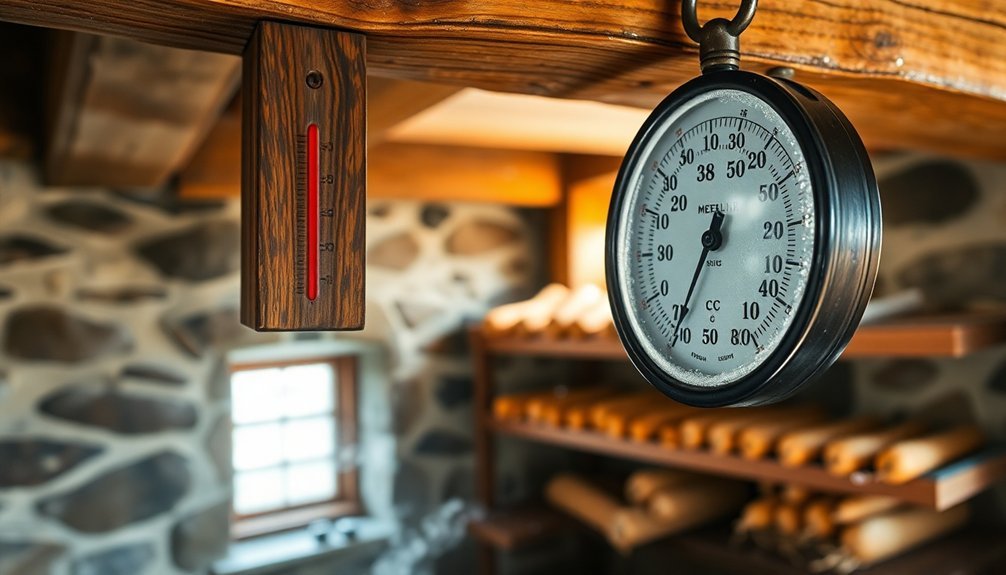
Successful winter storage in your root cellar depends on maintaining precise temperatures between 32-40°F (0-4°C) and monitoring humidity levels closely. You'll need to check these conditions regularly throughout the winter months to guarantee your produce stays fresh.
For best storage, you should harvest your vegetables at peak ripeness just before the first hard frost. Don't wash your produce; instead, gently brush off excess dirt. Before storing, make sure you've properly cured items like onions, garlic, and squash in a warm, dry area for at least a week.
You'll want to maintain humidity levels of 85-95% for most root vegetables and leafy crops, while keeping squash, onions, and garlic in areas with lower humidity (60-70%). You can increase humidity by sprinkling water on the floor or using damp burlap sacks.
Guarantee proper ventilation to prevent mold growth and remove ethylene gas. You should organize your produce with enough space between items for air circulation.
Check regularly for any signs of spoilage and remove affected items immediately to prevent spread. If you notice temperature fluctuations outside the ideal range, adjust your ventilation system accordingly.
Temperature-Related Storage Problems
Even with careful monitoring, temperature-related problems can seriously impact your root cellar's effectiveness. When temperatures drop below 32°F, you'll face frozen produce and potential structural damage from ice formation. Conversely, temperatures above 40°F will accelerate spoilage and promote unwanted sprouting in your vegetables.
Temperature fluctuations create additional challenges that can compromise your stored produce. You'll notice that these swings affect different vegetables differently, as each crop has its own specific temperature requirements. The humidity levels will also shift with temperature changes, potentially creating conditions for mold growth or excessive drying.
Here's what you'll need to watch for in your root cellar:
- Freezing damage to root vegetables, which destroys their cellular structure
- Increased ethylene gas production at higher temperatures, speeding up ripening
- Condensation issues during temperature swings, leading to moisture problems
- Accelerated microorganism growth when temperatures rise above 40°F
- Structural stress from freeze-thaw cycles, which can damage your root cellar
You'll need to maintain consistent temperatures between 32-40°F through proper insulation and ventilation to prevent these issues and preserve your produce effectively.
Frequently Asked Questions
Can I Use a Basement Dehumidifier in My Root Cellar?
You shouldn't use a dehumidifier in your root cellar since most produce needs high humidity (90-95%) to stay fresh. A dehumidifier would remove necessary moisture and could cause your stored items to dry out.
How Do Underground Springs Affect Root Cellar Temperature?
Underground springs can help maintain your root cellar's ideal temperature by naturally cooling the surrounding soil. You'll benefit from their steady cooling effect, but you'll need proper drainage to manage excess moisture they create.
Should I Store Homemade Preserves in the Same Root Cellar?
You shouldn't store homemade preserves in your root cellar. The high humidity (85-95%) can damage canned goods and affect their quality. Instead, keep your preserves in a cool, dry space around 60-65°F.
Does Painting Root Cellar Walls Affect Temperature Regulation?
No, painting your root cellar walls won't greatly affect temperature regulation. While lime washing can help with pest control, your focus should be on proper insulation, ventilation, and sealing gaps for effective temperature maintenance.
Can I Use Solar-Powered Ventilation Fans in My Root Cellar?
Yes, you can effectively use solar-powered ventilation fans in your root cellar. They'll help maintain proper airflow, regulate temperature, and reduce humidity while being energy-efficient. Just make certain they're properly positioned for ideal air circulation.
In Summary
Your root cellar's success depends on maintaining temperatures between 32-40°F (0-4°C) for most vegetables. You'll need to monitor and adjust ventilation, insulation, and humidity levels to keep conditions stable. Remember that different crops have specific temperature needs, so you might want to create separate zones. With proper temperature control, you can store your harvest throughout winter and avoid common problems like sprouting or rotting.

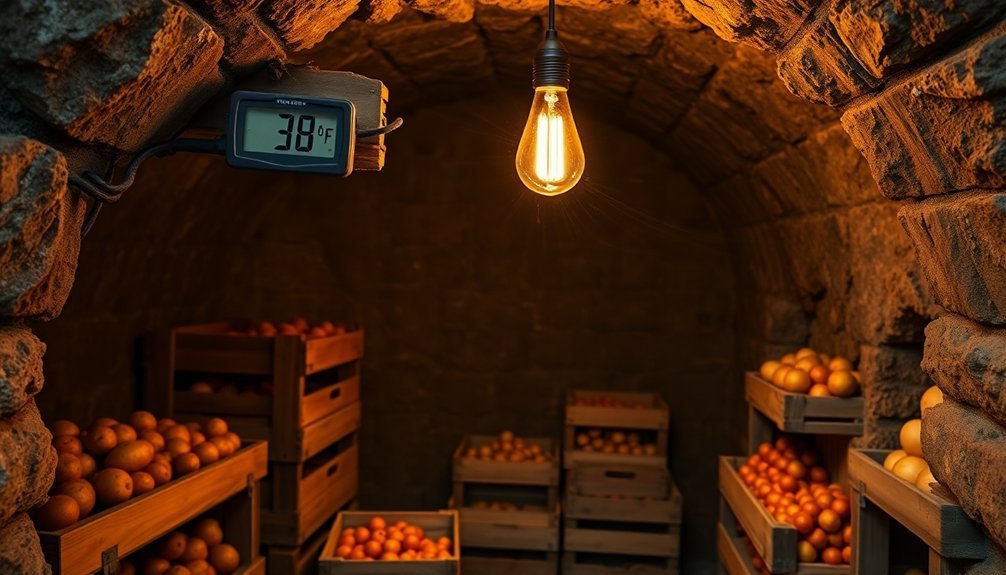



Leave a Reply